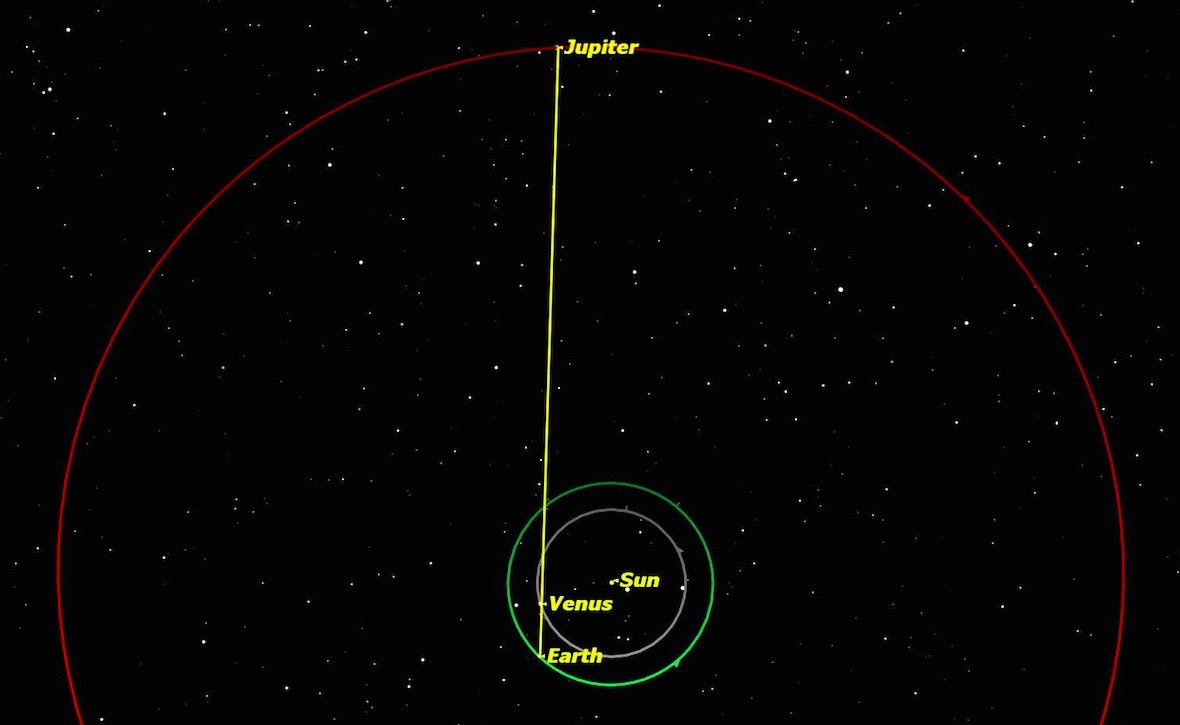Venus and Jupiter Put on a Celestial Show This Month

If you've been watching the western sky just after sunset lately, you will have noticed two bright objects, gradually drawing closer.
These are the two brightest planets, Venus and Jupiter. Venus is the brighter of the two, currently magnitude -4.6 on the upside-down brightness scale astronomers use. It will get slightly brighter over the next 10 days, reaching greatest brilliance on July 10 at magnitude -4.7.
Jupiter is somewhat fainter at magnitude -1.8, down from a maximum of -2.6 when it was in opposition on Feb. 6. [Skywatching in 2015: 9 Must-See Stargazing Events]
Although the two planets look very close together in Earth's sky, they are in fact very far apart, on opposite sides of the sun. The first graphic shows their true positions, as seen from far above the sun's north pole. Venus is slightly nearer Earth than the sun, 0.512 astronomical units (AU) distant (47.6 million miles, or 76.5 million kilometers), while Jupiter is 6.083 AU away (565 million miles, or 910 million km) on the far side of the sun.

Viewed in a telescope, the two planets are, by coincidence, exactly the same apparent size — 32 arc seconds in diameter, about 1/60 the apparent diameter of the moon — but they look very different.
Venus, with its bright cloud cover and closeness to the sun, is a brilliant white crescent, lit from slightly behind because it is moving between us and the sun. Jupiter's cloud tops are somewhat darker than those of Venus' but the gas giant is also more than seven times farther away from the sun. As a result, despite its large size, Jupiter appears much fainter in a telescope than Venus does.
Two bright planets in close proximity make a striking sight with the naked eye. In binoculars, you should be able to see that Venus is a tiny crescent and Jupiter is a disk accompanied by three moons (on July 1, Callisto will be behind Jupiter). A small telescope will make the view much clearer.
Get the Space.com Newsletter
Breaking space news, the latest updates on rocket launches, skywatching events and more!
As you continue to watch these two planets over the next few weeks you will see them draw apart as both get closer to the sun, Venus passing between Earth and the sun on Aug. 15, and Jupiter passing behind the sun on Aug. 26. In another month, both planets will reappear in the morning sky, where they will join Mars, which passed behind the sun on June 14.
This article was provided to Space.com bySimulation Curriculum, the leader in space science curriculum solutions and the makers of Starry Nightand SkySafari. Follow Starry Night on Twitter @StarryNightEdu. Follow us @Spacedotcom, Facebookand Google+. Originally published on Space.com.
Join our Space Forums to keep talking space on the latest missions, night sky and more! And if you have a news tip, correction or comment, let us know at: community@space.com.

Geoff Gaherty was Space.com's Night Sky columnist and in partnership with Starry Night software and a dedicated amateur astronomer who sought to share the wonders of the night sky with the world. Based in Canada, Geoff studied mathematics and physics at McGill University and earned a Ph.D. in anthropology from the University of Toronto, all while pursuing a passion for the night sky and serving as an astronomy communicator. He credited a partial solar eclipse observed in 1946 (at age 5) and his 1957 sighting of the Comet Arend-Roland as a teenager for sparking his interest in amateur astronomy. In 2008, Geoff won the Chant Medal from the Royal Astronomical Society of Canada, an award given to a Canadian amateur astronomer in recognition of their lifetime achievements. Sadly, Geoff passed away July 7, 2016 due to complications from a kidney transplant, but his legacy continues at Starry Night.










